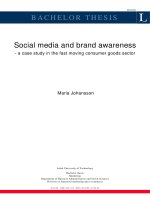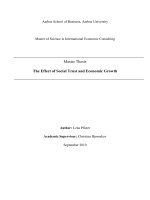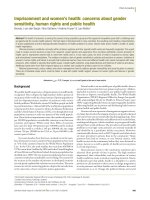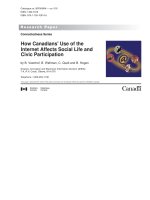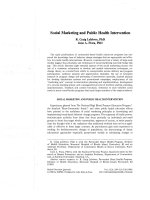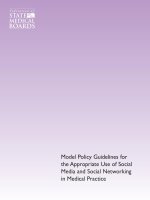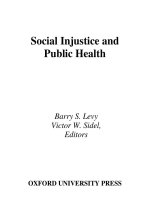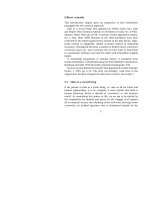Social Media and Public Relations pdf
Bạn đang xem bản rút gọn của tài liệu. Xem và tải ngay bản đầy đủ của tài liệu tại đây (3.68 MB, 177 trang )
ptg7913098
ptg7913098
Praise for
Social Media and Public Relations
“The desire to be strategic about social media and PR is no longer
enough—these days you must first master the eight new PR practices
laid out by Breakenridge. If you want to sit at the social media strategy
table, then read this book. Better yet, make sure you share it!”
—Charlene Li, author of Open Leadership and Groundswell, Founder
of Altimeter Group
“Never before has a book explained how PR is evolving like Deirdre
Breakenridge’s Social Media and Public Relations: Eight New Practices
for the PR Professional. The industry is in turmoil, as the digital era
begins to settle and PR is looking for a home among marketing, content,
and social media. Breakenridge breaks down eight areas to focus on
for both career and business growth, including research, reputation,
collaboration, and most importantly, measurement. It’s a must-read for
any PR practitioner, no matter level or expertise.”
—Gini Dietrich, CEO Arment Dietrich, Inc., founder Spin Sucks Pro,
author of Spin Sucks, and coauthor of Marketing in the Round
“I believe that any organization with strong values can succeed in
social, and the book Social Media and Public Relations explains how
in thoughtful (and necessary) detail. Anyone who tells you social is
easy has not done their homework, and understanding the wealth of
information in this book will keep them from failing the final exam.”
—George Faulkner, Social Brand Engagement Program, IBM
ptg7913098
With love and thanks to Megan, Mark, Mom,
and Dad, and my family—The Zieglers
and The Skrobolas—You’re my inspiration!
ptg7913098
Social Media and
Public Relations
Eight New Practices for the
PR Professional
Deirdre K. Breakenridge
ptg7913098
Vice President, Publisher: Tim Moore
Associate Publisher and Director of Marketing: Amy Neidlinger
Executive Editor: Jeanne Glasser
Editorial Assistant: Pamela Boland
Operations Specialist: Jodi Kemper
Senior Marketing Manager: Julie Phifer
Assistant Marketing Manager: Megan Graue
Cover Designer: Chuti Prasertsith
Managing Editor: Kristy Hart
Senior Project Editor: Lori Lyons
Copy Editor: Apostrophe Editing Services
Proofreader: Sarah Kerarns
Indexer: Erika Millen
Compositor: Nonie Ratcliff
Manufacturing Buyer: Dan Uhrig
© 2012 by Deirdre Breakenridge
Pearson Education, Inc.
Publishing as FT Press
Upper Saddle River, New Jersey 07458
FT Press offers excellent discounts on this book when ordered in quantity for bulk purchases
or special sales. For more information, please contact U.S. Corporate and Government Sales,
1-800-382-3419, For sales outside the U.S., please contact
International Sales at
Company and product names mentioned herein are the trademarks or registered trademarks
of their respective owners.
All rights reserved. No part of this book may be reproduced, in any form or by any means,
without permission in writing from the publisher.
Printed in the United States of America
First Printing April 2012
ISBN-10: 0-13-298321-4
ISBN-13: 978-0-13-298321-1
Pearson Education LTD.
Pearson Education Australia PTY, Limited.
Pearson Education Singapore, Pte. Ltd.
Pearson Education Asia, Ltd.
Pearson Education Canada, Ltd.
Pearson Educación de Mexico, S.A. de C.V.
Pearson Education—Japan
Pearson Education Malaysia, Pte. Ltd.
Library of Congress Cataloging-in-Publication Data
Breakenridge, Deirdre.
Social media and public relations : eight new practices for the pr professional / Deidre
Breakenridge. 1st ed.
p. cm.
ISBN 978-0-13-298321-1 (pbk. : alk. paper)
1. Social media. 2. Public relations. I. Title.
HM742.B74 2012
302.23’1 dc23
2012006991
ptg7913098
Contents
Foreword by David Armano viii
Introduction When Social Media Meets PR, Communication
Unites with Technology 1
Chapter 1 PR Practice #1: The PR Policymaker 8
Chapter 2 New Practice #2: The Internal Collaboration
Generator 23
Chapter 3 New Practice #3: The PR Technology Tester . . . . .37
Chapter 4 New Practice #4: The Communications
(COMMS) Organizer 54
Chapter 5 New Practice #5: The Pre-Crisis Doctor. . . . . . . . .71
Chapter 6 New Practice #6: The Relationship Analyzer 87
Chapter 7 New Practice #7: The Reputation Task
Force Member 103
Chapter 8 New Practice #8: The Master of the Metrics 118
Chapter 9 Using Your New PR Practices to Become an
Influencer and Change Agent 134
Chapter 10 The Future of PR and Social Media 146
Appendix A The Social Media Strategy Wheel 157
Index 160
ptg7913098
Acknowledgments
There are many PR and marketing professionals who are the inspi-
ration for Social Media and Public Relations: Eight New Practices for
the PR Professional. To them, I give my thanks and appreciation. I’m
amazed at my colleagues who seamlessly incorporate social media into
their programs as they educate and influence others around them. We
are increasing our knowledge and skills, and should give thanks to one
another as we share, innovate, and learn together.
Special thanks goes to my executive editor, Jeanne Glasser, for
believing in me and my book’s concept. A big thank you also goes to my
project editor, Lori Lyons, for her help in getting this book to market
and to the Pearson marketing team, including Megan Graue, who I have
worked with on earlier books, and whose promotional support is always
appreciated.
I also want to thank the many experts who participated in the book’s
development by sharing their knowledge; they truly helped me to illus-
trate the eight new practices. These experts include Mike Robertson
and Kyle-Beth Hilfer, Esq, for Practice #1; Michael Brito and Ariel
Hyatt for Practice #2; Derek Skaletsky and Jason Kintzler for Practice
#3; Joseph Provenza, Jay Baer, and Priya Ramesh for Practice #4; Sarah
Evans for Practice #5; Arik Hanson and Steve Momorella for Practice 6;
Leon Chaddock, Amber Naslund, and Mark Ragan for Practice #7; Katie
Paine, Shonali Burke, and Valerie Simon for Practice #8; and Brian Solis
and Chris Brogan for helping with the chapter on PR influencers and
change agents.
I’d like to acknowledge the marketing and PR colleagues who
have contributed to my writing process through their participation in
#PRStudChat, which is my student, professional, and educator commu-
nity on Twitter. Here, they shared ideas and insights, and constantly gave
me excellent information to shape the pages of this book.
Of course, my deepest appreciation goes out to my family. I thanked
my husband publicly on my Facebook Wall for being my “rock” through-
out the writing process. However, the thank you also extends to my
daughter, who did an incredible job with the social media wheel graphics
in every chapter, and to my parents and stepchildren, who see much less
of me when I’m writing a book. I’m very thankful for all of their support
and patience as I ventured down this writing path for the fifth time.
ptg7913098
About the Author
Deirdre K. Breakenridge is Chief Executive Officer of Pure Per-
formance Communications, a strategic communications and technology
consulting firm in the New York Metro area. A veteran in PR and mar-
keting, Breakenridge has counseled senior-level executives at Fortune
500 companies.
As a five-time published author and entrepreneur, Breakenridge
travels worldwide, speaking to corporations and associations on the
changing media landscape and the integration of public relations, mar-
keting, and social media. She is an avid blogger at PR 2.0 Strategies and
the cofounder of #PRStudChat, a dynamic Twitter community dedicated
to educating PR students, professionals, and professors. Her other books
include Putting the Public Back in Public Relations; PR 2.0 New Media,
New Tools, New Audiences and The New PR Toolkit.
ptg7913098
Foreword
Of all the industries to be affected by the massive changes brought
about by social media, Public Relations has been on the front lines since
the beginning. The reason is simple: Much of social media is done in
public, by the public, and the dynamics that have shaped public relations
in the past (media relations, interactions with opinion leaders and
influencers, and of course, crisis/reputation management) are not only
present in social media, but often accentuated and amplified by it.
Recent history is filled with scores of examples of how “social”
has dramatically affected brands and even business functions beyond
reputation—from “Dell Hell” to “Motrin Moms” to Kenneth Cole
promoting his brand at the expense of those sacrificing during the
Arab Spring. Social media has proven to upend not only modern day
communications processes, but it also possesses the potential to impact
a company’s bottom line or, at minimum, its reputation. It may not be
social media that broke the initial story of Apple’s labor practices, but it
is social media that keeps a story relevant and in the “newsfeeds” of our
lives—whether it be via Facebook, Twitter, or even niche networks such
as Pinterest.
The way we’ve looked at Public Relations in the past must be
re-thought or, at minimum, re-examined. In Edelman’s 2012 Trust
Barometer study, for example, the stakeholder who enjoyed the most
significant gain in perceived trust compared to the previous year was a
“regular employee.” Compare this to the stakeholder group that ranked
last (CEOs), and note that regular employees ranked just below “a
person like yourself” but above NGO representatives. The data suggests
a trend that indicates institutions and those who represent them remain
more challenged when it comes to trust versus individuals. If the Public
Relations industry were to find itself heading straight into the eye of the
perfect storm of it’s time, it might just be now.
Never before have professional communicators been tasked with
not only making statements, but also understanding “sentiment” viewed
not only through the eyes of traditional media, but also through the
eyes of the actual public who is empowered to communicate directly via
blog, tweet, post, and so on. In today’s communications landscape, the
journalist now shares the stage with scrappy niche publishers who can
break news without their help. The media industry has had no choice but
ptg7913098
Foreword
ix
to adapt to this—and many journalists, such as David Pogue from the
New York Times, now report and influence opinion showing a mastery
of not only traditional media techniques, but also of social media tactics.
All of this spells a singular reality for the modern-day communicator:
Adapt or die trying. Being a “PR pro” today means understanding
and being effective in community management. Practitioners must
understand more than ever how to play well with their counterparts in
customer service and advertising (especially digital), and the modern-day
communicator must understand business strategy—to not only respond
and adapt, but to also help shape favorable outcomes for the individuals,
organizations, and public they represent. This must be done with a level
of transparency and ethical standards that remain higher than ever as
social media has proven to punish those who attempt to manipulate it for
personal gain.
Deirdre Breakenridge has put together a comprehensive set of
guidelines, resources, opinions, and clear thoughts that are designed
for the communicators of today and tomorrow who have no choice but
to live and work in a real-time, data-driven world. Her constructs set
up a cohesive foundation that professionals both in-house and on the
services side will be able to benefit from. Her eight PR practices lay out
in detail what needs to be considered when PR meets social so that the
right infrastructure can be put in place before it’s even needed. Consider
these thoughts a blueprint for both communication and engagement in
an era of social business.
David Armano
EVP of Global Innovation & Integration for Edelman Digital and
author of the Logic + Emotion blog
ptg7913098
This page intentionally left blank
ptg7913098
1
Introduction
When Social Media Meets PR,
Communication Unites
with Technology
Public relations will continue to transform, and the changes you see
are monumental. For better or for worse, a career in PR means handling
communications in the public spotlight because of the increasing use of
social media. In the wake of democratized content and businesses satisfy-
ing the needs of the digitally connected consumer, PR had to evolve with
a new approach. This approach required a shift in thinking, from strategy
and planning all the way through to implementation and measurement.
Professionals must discover new research methods, develop specific poli-
cies to guide employee and public participation, experiment with content
through a variety of social media channels, and learn to connect and build
relationships with stakeholders through new technologies.
Every career requires competencies to succeed. In PR, you rely on
core competencies, including the ability to research and plan, apply strat-
egies to business goals and objectives, handle issues and crises communi-
cations, uphold professional and ethical behavior, manage organizational
resources, and demonstrate excellent communications skills. In an age of
new media and public conversations, your requirements expand.
In 2011, a pilot study conducted by Sergei Samoilenko of George
Mason University, Deborah Ballard-Reisch of Wichita State University,
and Bagila Ahatova of Kazakh University of International Relations and
World Languages, focused on how “Modern organizations must depend
on a new type of communication specialist to creatively solve problems
and adapt to rapid organizational change, a global marketplace, and con-
stantly emerging online communities.” The researchers designed a com-
munication competency instrument using a framework developed by
Pamela Shockeley-Zalaback (2009). The model consists of four major
components: knowledge, sensitivity, skills, and values.
ptg7913098
2
Social Media and Public RelationS
The research project, conducted in Kazakhstan, the ninth-largest coun-
try in the world by land area,
1
was distributed to professionals holding
upper-management positions in public relations. A multi-method survey
probed the respondents’ expectations about “crucial communication com-
petencies that university graduates with a degree in public relations should
possess in order to be successful in their organizations.” Among the many
interesting findings from the study included how the surveyed employers
“identified competence in using new information technologies, relationship
building, self-control, ability to initiate dialogue ” as the most important
skills for young professionals. Whether it’s young professionals entering the
workforce or seasoned practitioners, the competent use of information
technologies is a necessary skill, which has become a part of the PR profes-
sional’s daily practice.
2
Social media requires you to shift your mindset to unite communica-
tions and collaborative technology. When you adopt a new attitude and
expand your knowledge and skills, the result leads to successfully incorpo-
rating new practices into your daily responsibilities, personally and profes-
sionally. Despite the question, “Who owns social media in an organization?,”
PR and communications professionals are in an excellent position to strate-
gically guide all types of communications for their companies, including
social media. It’s time to seize the opportunity to learn and embrace com-
munications and technology, from the inside out.
Each new practice introduced in Social Media and Public Relations is
the result of what happens when social media meets PR and communica-
tions unites with technology. Following are the eight new practices vital to
your role today.
PR Practice #1: The PR Policymaker
The PR Policymaker is a professional who quickly learns that a cru-
cial part of the communications strategy and planning process includes the
development of social media policies, training, and governance. Not only
developing social media policies, but also maintaining them falls within this
new PR practice.
1
Kazakhstan, Wikipedia entry, January 2012.
2
Samoilenko, Sergei, Ballard-Reisch, Deborah, and Ahatova, Bagila, “Evaluating
Employer Communication Competency Expectations in Kazakhstan,” Research
Paper, Annual Convention of the National Communication Association, November
2011.
ptg7913098
intRoduction: When Social Media MeetS PR
3
PR Practice #2: The Internal Collaboration
Generator
The Internal Collaboration Generator is the communications profes-
sional who appreciates how social media collaboration starts on the inside
of the organization. Because social media moves across the company, it’s
imperative you work with specific departments (PR, Advertising, Mar-
keting, HR, IT, Legal, Sales, and so on). You are breaking down the silos
to increase sharing, collaboration, and innovation for better internal and
external communication.
PR Practice #3: The PR Technology Tester
The PR Technology Tester uses technology strategically for greater
peer-to-peer communications. At the start of social media, PR was criti-
cized for not being up to speed on the knowledge and use of social media
channels, tools, and technology resources. As a PR Technology Tester,
you are not only knowledgeable, but also testing the latest technology
for better interactions with the public. The effective use of information
technologies is a new core competency.
PR Practice #4: The Communications
(COMMS) Organizer
The COMMS Organizer is the PR professional who must educate and
redirect an organization to implement a new communications process.
No longer can companies solely rely on the push or broadcast method to
distribute their messages. Now, it’s your responsibility to make sure your
company’s stakeholders are pulling information from the organization.
You create new types of stories by developing, coordinating, and curating
content through different channels.
PR Practice #5: The Pre-Crisis Doctor
The Pre-Crisis Doctor is the PR professional who realizes every
company today can face a crisis. As a Pre-Crisis Doctor, you proactively
build crises prevention plans with comment response charts and helpful
ptg7913098
4
Social Media and Public RelationS
tools to identify and illustrate levels of crises escalation through all media,
including new media. Your new practice requires you to catch the negative
sentiment and ease a potentially explosive situation before it escalates to
crises proportions.
PR Practice #6: The Relationship Analyzer
The Relationship Analyzer is the PR professional who turns into the
communications sociologist with the help of technology. You must observe
and analyze how audiences connect—not only with their favorite brands,
but also with their peers in web communities. Your new skills include visu-
alizing and mapping the connections for better strategic engagement and
higher-level interactions.
PR Practice #7: The Reputation Task Force
Member
The Reputation Task Force Member is the PR professional who prac-
tices reputation management on steroids. Because social media can change
a company’s reputation drastically in a short amount of time, PR profession-
als must teach about core values and brand voice. They must turn on their
tracking/monitoring to high speed to respond with immediacy, constant
accuracy, and transparency.
PR Practice #8: The Master of the Metrics
The Master of the Metrics is the PR professional who moves from just
accepting metrics (no more Advertising Value Equivalents) to forging ahead
with measurable objectives and metrics tied to higher-level organizational
goals. In this practice, you learn to differentiate between social media busi-
ness outcomes versus the outtakes and outputs. Measurement has always
been a challenging area, and your level of accountability is even higher with
respect to social media communications.
After you read Social Media and Public Relations: Eight New Practices
for the PR Professional, you can fully understand what happens when social
media meets PR. The union of communications and technology offers PR
professionals the potential to mold their performance in a more strategic
direction. You can also crystallize how PR has expanded and the tremendous
ptg7913098
intRoduction: When Social Media MeetS PR
5
opportunity that awaits you. With new social media practices surfacing,
your development and application of strategic activities versus many of
the tactical functions in the past raises the value of PR—not only in the
eyes of organizational executives, but also how it appears in the eyes of
the public.
Your eight new practices can become a part of your social media
strategy and planning, which includes the research and discovery pro-
cess, goal and objective setting, budgeting, monitoring/tracking, chan-
nel distribution, communications messaging and content optimization,
levels of engagement, and benchmark measurements. Figure I.1 shows
the Social Media Strategy Wheel. (For more information regarding the
Social Media Strategy Wheel, with details about its components, visit the
Appendix.)
'
L
V
W
U
L
E
X
W
L
R
Q
&
K
D
Q
Q
H
O
V
7
U
D
F
N
L
Q
J
0
R
Q
L
W
R
U
L
Q
J
6
R
I
W
Z
D
U
H
(
Q
J
D
J
H
P
H
Q
W
Z
D
\
&
R
Q
Y
H
U
V
D
W
L
R
Q
V
(
[
S
H
U
L
H
Q
F
H
6
H
Q
W
L
P
H
Q
W
0
H
D
V
X
U
H
V
/
H
D
G
V
6
D
O
H
V
%
U
D
Q
G
/
L
I
W
$
Z
D
U
H
Q
H
V
V
+
L
J
K
9
D
O
X
H
,
Q
W
H
U
D
F
W
L
R
Q
V
2
S
W
L
P
L
]
H
&
R
Q
W
H
Q
W
&
U
H
D
W
L
R
Q
7
U
D
F
N
L
Q
J
0
R
Q
L
W
R
U
L
Q
J
6
W
U
D
W
H
J
\
(
Q
J
D
J
H
P
H
Q
W
6
W
U
D
W
H
J
\
0
H
D
V
X
U
H
P
H
Q
W
6
W
U
D
W
H
J
\
&
R
Q
W
H
Q
W
&
R
P
P
X
Q
L
F
D
W
L
R
Q
V
6
W
U
D
W
H
J
\
'
L
V
W
U
L
E
X
W
L
R
Q
6
W
U
D
W
H
J
\
2
E
M
H
F
W
L
Y
H
V
*
R
D
O
V
$
X
G
L
H
Q
F
H
3
U
R
I
L
O
H
%
X
G
J
H
W
$XGLW
'LVFRYHU\
5HVHDUFK
Figure I.1 The Social Media Strategy Wheel
Applying these eight practices successfully as they apply to your
social media strategy and planning within your organization is a chance
ptg7913098
6
Social Media and Public RelationS
to claim your seat at the strategy table. And based upon the nature of the
new practices, you can connect to the solutions that keep executives up
at night. For this reason, you need to be at the strategy table. Of course,
before you dive into learning more about the eight new practices, you must
realize mastering public relations today does not mean abandoning core PR
principles. No matter what new practices you incorporate into your role,
and your company’s communications programs, you must always rely on
your strong sense of ethics, critical thinking, keen negotiating skills, unique
ability to liaise and build relationships, passion for information and research,
and your love of written and verbal communication. These are the tenets of
PR, naturally embedded in what you do, especially when you move forward
with a new practice.
To fully apply the eight new practices, you must start with a different
frame of reference. Be prepared to move PR out of its silo and to learn how
to (1) incorporate new knowledge and skills into your work; (2) expand your
knowledge of other marketing and digital practices, as you become a hybrid
or integrated new media professional; (3) act as a liaison to create unique
bonds between different groups that don’t normally work together within
the organization, all functioning harmoniously for better internal as well as
external communications; and (4) become a PR champion/influencer who
educates others and spearhead a change movement.
The new PR mindset takes into consideration how PR extends beyond
what you were used to in the traditional realm, what you’ve started to master
in the online PR arena, and what you’ve dabbled with in social media. The
new mindset is what you can look forward to as you see more businesses
becoming “socialized” to meet the needs of their customers. Social media is
moving across the organization, from marketing and sales to IT and product
development. The future of PR and communications is how you adapt and
learn the new practices and how you help your peers to adapt. Embracing
new knowledge and skills means you’re ready to also move forward to shift
the mindset of your organization. The PR professional who works to incor-
porate new practices into the organization must go through several phases
of change. The goal is to be a propelling force, leading the charge, and a
change agent who makes the new practices systemic in your organization.
The future of PR lies in your hands, in the hands of the PR influencer
and change agent. How you embrace a new way to think and apply the
necessary knowledge and skills determines the direction of your role in PR.
You either become increasingly more important and a valuable asset, or
if all remains the same, you unfortunately someday become obsolete. PR
has a tremendous opportunity, with an expansion affecting how businesses
ptg7913098
intRoduction: When Social Media MeetS PR
7
connect with their constituents for deeper engagement. It’s the differ-
ence between PR that simply leads to handling and facilitating messages
to the type of PR work that results in powerful information exchange
and deeper and more meaningful relationships. It begins with you, the
communications professional, and your willingness to accept new prac-
tices. Social media and public relations together have moved you to a
new plateau. Many exciting changes lie ahead. Learn, embrace, practice,
and excel.
ptg7913098
8
PR Practice #1: The PR Policymaker
Social media has uncovered the need for professionals to be more
closely tied to policymaking, but in a capacity that’s different from that in
the past. Companies realized not only did their customers want to talk
about them in their social media communities, but their employees were
also talking. As you may have guessed, the conversations weren’t always
positive. Whether these organizations opened up the social channels will-
ingly for active involvement or mistakenly shut them down to “protect”
the brand, stakeholders were going to communicate a lot! Regardless of
an organization’s position on social media, employees like customers
found ways to share information through new channels. For employees,
it was either tied directly to their daily work activities and personal life, or
a mixture of both.
In October 2011, 65% of U.S. companies had a social media policy in
place, governing the employee use of social networking sites.
1
Suddenly,
the role of the professional involved in developing the social media poli-
cymaker is front and center. The PR Policymaker is the professional
who spearheads and guides the social media policy development process.
A once less-known and vacant spot needs to be filled quickly. This was a
wake-up call to many company executives. In some cases, it was the “Uh
oh,” moment, and in other cases for the forward thinking, it was the “Ah
ha” moment. Public relations professionals were right there, in either
case, to lend assistance. For the latter, PR alerted company executives
that there had to be some social governance for employee communica-
tion in the social landscape, and guidelines were also necessary to teach
the public how to participate with the brand on various social properties.
Teaching people how to participate through social channels in not
meant to stifle communication. On the contrary, PR professionals know
policies are created to guide and protect all parties participating. The
1
1
Premo, Karen and Vollmer, Christopher, “Campaigns to Capabilities Social
Media & Marketing 2011,” Booz & Co., October 2011.
ptg7913098
Chapter1•prpraCtiCe#1:theprpoliCymaker
9
role of the PR Policymaker helps the company, its employees, and the
public to join in conversations the right way and to engage with purpose,
in a safe environment that’s created for learning and sharing. Kodak dis-
cusses this approach by stating in its policy “Maintaining a good reputa-
tion—yours and Kodak’s” and “Protecting your[s], and Kodak’s, privacy
and resources,” referring to everyone who is active on the Kodak social
media properties.
2
The PR Policymaker practice must begin when you first develop
your social media plan. Figure 1.1 shows the Social Media Strategy
Wheel with the Audit/Discovery/Research portion of the process where
policies need to be identified and fleshed out to create an environment
that respects and protects all parties involved.
What Are the Responsibilities
of the PR Policymaker?
Stepping up to help champion the social media policy development
process is a critical role in the organization; one well suited for the PR
professional. From past experience, working with different companies
and professionals, the PR Policymaker is responsible for four areas that
help his team to build and communicate an effective policy, including
the following:
•Getting ready for policy development
•Assembling a core social media team to assist in policymaking
•Doing the research and the policy writing process
•Communicating and measuring policy compliance
Getting Ready for Policy Development
When you prepare for the development process, a social media
audit, or profile review, is the policy starting point. The audit is critical
to the success of how you move forward. Although an “audit” typically
2
Kodak Social Media Tips, “Sharing Lessons Learned to Help Your Business
Grow,” 2009.
ptg7913098
10
SoCialmediaandpubliCrelationS
refers to an outside third party who objectively reviews the social media
profile information, in many cases you may not have the resources to call in
a third party. Therefore, you must research and uncover the weak or poten-
tial areas of concern, with respect to communications on your brand’s social
profiles (Twitter, Facebook, YouTube, LinkedIn, and so on).
'
L
V
W
U
L
E
X
W
L
R
Q
&
K
D
Q
Q
H
O
V
7
U
D
F
N
L
Q
J
0
R
Q
L
W
R
U
L
Q
J
6
R
I
W
Z
D
U
H
(
Q
J
D
J
H
P
H
Q
W
Z
D
\
&
R
Q
Y
H
U
V
D
W
L
R
Q
V
(
[
S
H
U
L
H
Q
F
H
6
H
Q
W
L
P
H
Q
W
0
H
D
V
X
U
H
V
/
H
D
G
V
6
D
O
H
V
%
U
D
Q
G
/
L
I
W
$
Z
D
U
H
Q
H
V
V
+
L
J
K
9
D
O
X
H
,
Q
W
H
U
D
F
W
L
R
Q
V
2
S
W
L
P
L
]
H
&
R
Q
W
H
Q
W
&
U
H
D
W
L
R
Q
7
U
D
F
N
L
Q
J
0
R
Q
L
W
R
U
L
Q
J
6
W
U
D
W
H
J
\
(
Q
J
D
J
H
P
H
Q
W
6
W
U
D
W
H
J
\
0
H
D
V
X
U
H
P
H
Q
W
6
W
U
D
W
H
J
\
&
R
Q
W
H
Q
W
&
R
P
P
X
Q
L
F
D
W
L
R
Q
V
6
W
U
D
W
H
J
\
'
L
V
W
U
L
E
X
W
L
R
Q
6
W
U
D
W
H
J
\
2
E
M
H
F
W
L
Y
H
V
*
R
D
O
V
$
X
G
L
H
Q
F
H
3
U
R
I
L
O
H
%
X
G
J
H
W
$XGLW
'LVFRYHU\
5HVHDUFK
3
353UDFWLFH7KH353ROLF\0DNHU
Figure 1.1 Social Media Strategy Wheel: PR Practice #1
The social media audit is usually conducted to identify any challenges or
problem areas within a brand’s current program, as well as to pinpoint gen-
uine opportunities that have been working with respect to participation and
engagement in the social media landscape. Similar to a Strengths, Weak-
nesses, Opportunities, and Threats (SWOT) exercise, the results enable you
to work on your weaknesses and capitalize on your strengths. Then, you can
move the best of your program forward, as part of your communications
strategy.
ptg7913098
Chapter1•prpraCtiCe#1:theprpoliCymaker
11
During the audit, you identify and evaluate all the existing social
media properties for the following:
•Type and size of community, where size may be used as a bench-
mark for growth over time.
•Brand guideline and usage of proper logo, colors, accepted imag-
ery, and so on for social profiles.
•Engagement with stakeholders, rated on a scale of 1 to 10, with 10
being highly engaged in two-way, meaningful interactions. There
is a difference between a brand that informs with news and articles
and has a stream of information versus a brand that has discussions
and high levels of engagement, answering questions and obtaining
feedback about products and services.
•Strategy or purpose of the social profile, whether your social site is
used for awareness, customer service, research, and crowdsourc-
ing, and to drive people to the company’s website.
•Frequency of the conversations, which can be hourly, daily, weekly,
monthly, or the less frequent, sporadic sharing of information.
•Types of content shared, including links to news articles, blog
posts, videos, photos, events, widgets, applications, and so on.
•Tracking and measurement used to evaluate the properties, which
may include free tools and paid platforms, with charts and graphs
for reporting analytics.
By analyzing all the information you retrieve in the audit, you can
quickly see clear differences in your properties for brand guidelines, con-
tent usage, coordination of content, measurement not tying back to your
objectives or goals, and whether your audience interacts with your brand,
or each property is just another marketing channel with one way com-
munication (which should not be the purpose of a social media channel).
At the same time, you may also discover certain properties are outpacing
others based on excellent sharing habits and the ability to offer infor-
mation that touches on a community’s passion or critical issues. All the
information in the audit will be the areas you address in your policy—for
example, how your employees should use content and what is acceptable
use, how to set up a strategic social media channel, proper account man-
agement, and following the standard brand guidelines, to name a few.
After you complete your social media audit, you may also want to
use this intelligence as an opportunity to compare your findings against
ptg7913098
12
SoCialmediaandpubliCrelationS
those of your competitors. It’s important to uncover and capture the same
data and information on your direct competition to see their strengths and
weaknesses in social media. You would use the identical approach to analyze
whether their properties and brand voice are consistent, how frequently
they post, and whether they engage on a higher level, more so than your
company. You can tell immediately which competitors actually have a stra-
tegic approach to social media or if their thinking is tactical, piecemeal, and
an unorganized, disjointed effort.
The PR Policymaker also capitalizes on the situation by using all the
information from the audit to evaluate and fix what’s currently wrong with
a social media program. It’s also an excellent way to recognize the positive
aspects that may already be in place. You must update your social media
plan every six months or yearly, and it’s vital to conduct your audit at the
same time, so you can plan forward. You’re probably asking, “How am I
supposed to audit 50 different Twitter handles, 30 Facebook pages, and 20
YouTube channels every time we develop a new plan?” For larger brands,
it’s a cross-section of profiles reviewed by the policymakers, or you can
break down the audit exercise and delegate to individuals in specific depart-
ments (under your direction). Prior to policy development, you may quickly
find that many of these profiles are inactive and have gone “dark,” which
means they have no activity at all. In the future, if you include a procedure
for setting up profiles with a strategic purpose in your policy, it can prevent
many of the inactive profiles from surfacing.
Assembling a Social Media Core Team to Assist
in Policymaking
PR Policymakers don’t wait to be assigned the role. You must take ini-
tiative to introduce management formally to the team approach and a pro-
cess that must be put into place for the organization. You need to work
with senior management to determine what social media champions will be
a part of the Social Media Core Team—a team of dedicated professionals
who work together to create vision and strategy, as well as help with policy
development. PR cannot build a social media policy in a vacuum.
When you build the Core Team, likely candidates include PR, Market-
ing, Web, and IT personnel; although there are times when Legal, HR,
Sales, and other groups are asked to join the team at the onset. When you
assemble your Core Team, you can set up dedicated times to meet and dis-
cuss policy development.
One of the first action items for the Core Team is to review the results
of the social media profile audit and then to develop questions directly
ptg7913098
Chapter1•prpraCtiCe#1:theprpoliCymaker
13
resulting from the audit. Highlighting the right questions can uncover
important objectives, goals, liabilities, marketing needs, core areas of
focus, and so on. Following are some important questions to ask before
you dive into social media policy development:
•What are the objectives of a social media policy, keeping in mind
different departments will have different objectives?
•What potential issues, risks, or liabilities did you uncover in your
audit, and as a result, what areas need to be addressed in your
policy?
•What are the main areas of focus that can help guide your employ-
ees and their participation?
•Do employees understand social media, or should there be educa-
tion included in the policy?
•Who will be responsible to set up social media properties and
the management of those brand profiles? Will this be done by
department(s) or the central area, and does this information need
to be documented in the policy?
•What are the concerns or issues from the various departments
that need to be included? That is, is HR concerned about profile
account information, or is Legal concerned about privacy issues
and intellectual property issues?
•Should the policy include statements on an employee’s personal
versus professional use of social media?
•What is the best way to share information with employees when
you first introduce the policy, as well as when you need to share
updates in the future?
•Who will maintain the policy and continually update it moving
forward?
These questions and the policies you develop go far beyond the
“Rules of Engagement,” which are the common ways companies instruct
their employees to participate. Many companies devise Rules of Engage-
ment to get their employees communicating via social channels quickly
and with good common sense guidance. However, because of numerous
employee lawsuits, your policies must go well beyond the fundamentals
and be much less ambiguous than earlier policy work. The New York
Times article in November 2010 documented one of the first legal battles
in which an employee posted negatively about a supervisor and then was
“unfairly” let go by the company. The National Labor Relations Board
ptg7913098
14
SoCialmediaandpubliCrelationS
claimed that the employee’s rights were violated and that the company’s
Facebook rule was “overly broad” and improperly limited employees’ rights
to discuss working conditions among themselves. It is cases such as this one
that make companies more aware of the importance of a well-written and
unambiguous policy to better protect the rights of employees, as well as
employers.
3
Doing the Research and Policy Writing Process
Writing the social media policy for your organization may seem like a
daunting task. The number-one question is where do you start? Many com-
panies begin communicating in the social media landscape and then need
to step back to build their policies. There are many different approaches,
however. The following is an easy way to tackle the development of your
social media guidelines:
•Select five or six strong social media policies that have been created
by other organizations. Compare different types of policies, but be
sure you find policies representative of your industry, nonprofit or
government sector. One of the best sources for reviewing policies
and social media governance is the website, www.socialmediagover-
nance.com, with more than 150 policies for review.
•Use the results of your social media profile audit to guide you in
the policy writing. All the weaknesses you identified tell you which
areas of focus need to be addressed in your policy; that is, brand-
ing guidelines, policy set up and account management process, Rules
of Engagement, strategic purpose, legal concerns, and so on. These
areas can help you develop a matrix approach comparing what you
think you need versus what other similar companies develop and
include in their policies.
•Create a matrix or Guidelines for Engagement that includes the five
or six companies (listed in columns across your matrix) you select,
and then list the various sections these organizations use in their
social media policies. (Use the last column on the left side of your
matrix to list these potential areas.) Select relevant parts from each,
especially the guidelines that you feel pertain to activities within your
organization, as well as other issues or concerns that look useful. Add
3
Greenhouse, Steven, “Company Accused of Firing Over Facebook Post,” The New
York Times, November 8, 2010.

